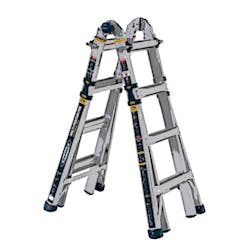NFPA Standards: NFPA 1931: Nontraditional Ladders and Accessories
You are assigned to work the ladder, and while you are checking out the truck, you are dispatched for a house fire. It’s in a poorer neighborhood that’s filled with old housing stock. When your company arrives at the fire, you find a three-story Victorian that hasn’t been painted since former President Ronald Reagan was in his first term in the White House. The chief points to the third floor and orders you to vent the roof. No problem, right? The chief knows that your crew is good: Your company has practiced “the old up and over,” and if you ladder the B side, you then can hit the third floor. It’s going to present some challenging work, but you’ve got this.
After a bit of difficulty (hoarding, of course), the first-in engine stretched its line to the second floor and reports that the smoke is banking down and that it’s getting rather hot. The chief asks about your progress, and your officer tells him that you are ready to start making cuts. The voice of the guy on the tip changes. He doesn’t sound quite so cool as minutes ago, and you know it must be getting tenuous down there.
You lean out from the roof ladder and drive the spike end of the Halligan into the roof, and it’s ugly. You step out, and it becomes obvious that the pitch of the metal roof is steeper than you realized. The Halligan isn’t holding well. You have a choice to make, and time isn’t on your side. Do you take greater personal risk to decrease the risk to someone else?
What if there was a better option?
After you have returned to the firehouse, you pull the chief aside and tell him that you need one of those work platforms that mounts to the roof ladders. He replies, “Sure. No problem. Just one question: Are they NFPA-certified?”
And here we go again.
Laddering evolves
Ladders have been around for a long time—a really long time. In 1736, when Benjamin Franklin founded the Union Fire Company in Philadelphia, the first purchase that the fire company made was ladders. With the exception of most of us in the fire service switching from wood to aluminum, our ladders basically haven’t changed in the following 285 years.
A couple of years ago, I submitted public comments to the Technical Coordinating Committee for NFPA 1931: Standard for Manufacturer’s Design of Fire Department Ground Ladders. The standard was up for its five-year review.
Products that can be found at big-box home improvement stores—ladder jacks, cinches, pole lashes, stand-offs, illumination kits, levelers, safety steps and work platforms—that would enhance the safety of this mission-essential piece of equipment—the ground ladder—weren’t being purchased by departments, because those products weren’t addressed by the standard. Mind you, the products weren’t prohibited, but the silence was deafening.
Multipurpose ladders needed to be included in the standard, because they were being used on the fireground in place of folding ladders. Furthermore, they already were included in the latest revision of NFPA 1901: Standard for Automotive Fire Apparatus. Also, a number of accessories, such as the SureFoot Safety Step, have been used in the field for more than a dozen years.
Meanwhile, manufacturers of accessories have been asking the testing laboratories whether they could get their products tested. There was no mechanism to test these accessories, because the standards were silent on them. There were no tests that were set up by the laboratories to characterize what the load would be and what would constitute failure.
New elements of the standard
Multipurpose ladders are ground ladders that are capable of being used as either a step ladder or as a straight ladder. They are made from two telescoping, adjustable-length sections that are connected via a hinged assembly.
The 2020 edition of NFPA 1931 defines an accessory as any “device that—when installed or attached to a ladder—expands the ladder’s function, utility and safety but is not essential for the ladder’s intended function.”
The standard doesn’t recommend or require the use of any specific ladder, multipurpose or otherwise. It likewise doesn’t indicate which ladder to use or when to use it. That’s covered in other standards. (Note: NFPA standards have specific regulatory language. For example, when the word “shall” is used, it indicates a mandatory requirement. The word “should” indicates a recommendation or something that is advised but not required. That said, this language wasn’t used in the ground ladders standard in reference to multipurpose ladders.)
There were multiple requests for stipulations to be included if accessories were to be addressed in the standard: Ladder accessories shall not interfere with extension, retraction or nesting of the fly section of a ground ladder or with halyards, hooks, dogs/pawls, hardware, pulleys or stay poles; and the accessories wouldn’t be permitted to interfere with the performance of the ladder in testing or in the use in the field. Also, the manufacturers of the ladders didn’t want to assume any liability for accessories. All of these ideas were deemed to be reasonable and, as a result, ended up in the latest document.
Chapter 5 of the standard states that ladder accessories shall not interfere with the operation of the ladder or inhibit the function of any component parts. The same chapter notes that ladder accessories shall not increase the overall dimensions of the ladder and shall not use metals that cause electrolytic action or compromise the duty rating of the ladder. Ladder accessory manufacturers shall provide service and use instructions for their products, including recommended preventive maintenance checks and schedules and installation and removal instructions for the ladder accessories. The manufacturers of the ladder accessories are required by the standard to list the specific ladders with which their products are approved for use.
We did our best to improve the NFPA standard on ground ladders. Now all you have to do is to get the chief to say yes.
About the Author

William Finegan
William Finegan is a fire paramedic lieutenant for the Philadelphia Fire Department. He has more than 35 years' experience in both paid and volunteer systems. Finegan participated in the revision of NFPA 1931: Standard for Manufacturer's Design of Fire Department Ground Ladders.
